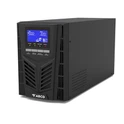Not all electrical equipment need to use the UPS, when choosing the UPS, mainly should consider the size of the load, load characteristics and importance and discharge time.

●(1) Characteristics of the load. Computers and their peripherals are mostly rectifiers with capacitive loads, and there is an impact current when they are started. Even in normal operation, the peak value of the current is 23 times of its effective value. Therefore, this characteristic should be taken into account when selecting UPS, and a certain amount of allowance should be left for UPS.
●(2) Calculate the load size and UPS capacity. Computer equipment load power factor between 0.65-0.7, the rated power vector of each load can be accumulated to calculate the total power, UPS capacity according to the following formula: UPS capacity ≥ load capacity /0.8.
That is, the load capacity should be less than 80% of the rated capacity of the UPS, taking into account the load startup impulse current.

●(3) Discharge time configuration. The standby time of a long-acting UPS is mainly limited by battery cost, installation space, and battery charging time. In areas with poor power environment and frequent power outages, UPS and generators are used to supply power. If the power failure lasts for a long time, you can start a backup generator to supply power to the UPS. When the mains is restored, the UPS switches to the mains.
●(4) Calculation of battery power supply time. The battery power supply time is affected by the load, battery capacity, ambient temperature, and battery discharge cut-off voltage. You can calculate the battery discharge current and determine the discharge time based on the battery discharge curve.
Battery discharge current can be calculated according to the empirical formula:
Discharge current =UPS capacity (VA) x power factor/average discharge voltage of battery x efficiency;
To calculate the actual load discharge time, replace the UPS capacity with the actual load capacity






